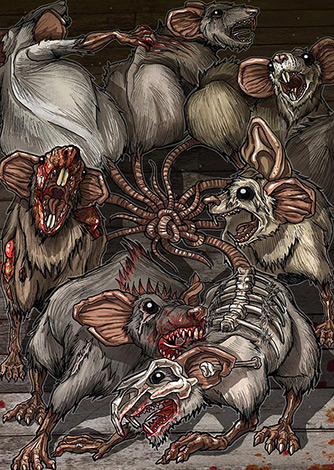
The phrase “rat king” in most people is associated with the evil hero of the fairy tale “The Nutcracker” - a huge rat with three heads, commanding its subjects. That is what, in the opinion of an ordinary person, a king in a rat kingdom looks like.
Someone thinks more pragmatically and considers such a king a certain rat, sitting at the top of the hierarchical pyramid and controlling its "subjects." It is the “servants” who provide him with food, drink, and other benefits, although outwardly the lord is no different from his own subordinates.
But what is the rat king from the point of view of science? Let's figure it out ...
The rat king - a myth, or a real natural phenomenon?
From a scientific point of view, the rat king is a rare natural phenomenon in which the tails of several rats intertwine so tightly that animals cannot untangle them. Animals in such trouble are not able to coordinate their movements and, as a result, cannot purposefully move and get food, and therefore quickly die from hunger.
The photo below shows the rat king, or rather, what is left of him:
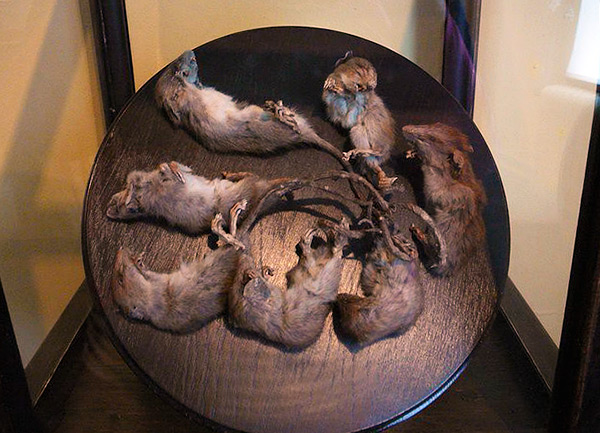
Such findings are very rare: no more than a few dozen remains of rat kings have been documented throughout the world. They were all discovered by ordinary people quite by accident, on ordinary farms and mills, near the basements. Of course, such monsters immediately generated many myths and completely unrealistic judgments about themselves, especially in ancient times, when even pundits found ridiculous explanations for such things. And when the disgust of people in front of the rats themselves and their tails was also added to the uniqueness of the phenomenon, absolutely monstrous legends arose ...
In the simplest popular interpretation, such a multi-bodied rat king is the master of rats, who controls his subjects, and they feed and serve him. More sophisticated hypotheses are already filled with mysticism and give the king a connection with the dark world, various supernatural abilities. From a scientific, evidence-based point of view, such hypotheses have nothing to do with reality.

On a note
By the way, the terminology in myths and in science is quite strict. It is incorrect to say “the king of rats”, especially - “the queen of rats” or “rat queen”. Both in mythology and in zoology it is customary to call the phenomenon “rat king”, and nothing else.
It is wrong to assume that the rat king is a kind of monster rat with two heads, an extra paw or an unusually large size. Modern genetics in the laboratories have created many such monsters, but to the fact that science understands the term "rat king", these creatures have nothing to do.
Likewise, an individual occupying a privileged position in a rat colony is not called a rat king. Although a certain hierarchy exists in a rat colony, it is not customary to call it a “leader” as a king. Moreover, scientists strongly doubt that rats with tangled tails can live long and occupy at least some significant place in the hierarchical pyramid.
What do we know about rat kings?
The main mystery of rat kings is that no one has ever found them alive - only the findings of long-withered corpses are documented. There are neither photos, nor videos, nor reports of scientists about living rat kings, which means that there is no firm conviction that such kings can live for at least some time.
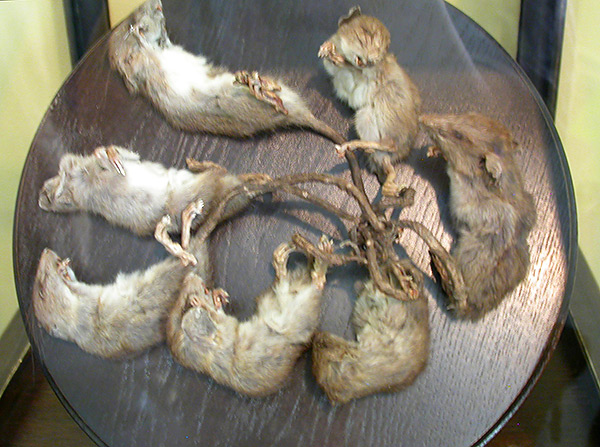
On the other hand, it is difficult to imagine that the tails of rats would weave into an untangled knot after death.Quite the contrary, the version seems plausible that it is precisely because of the constant fuss of animals that their tails can form such a knot.
It is also a plausible assumption that, in fact, tangled tails do not allow animals to normally obtain food and lead to death. It is known that rats cannot starve for longer than 3-4 days. So, after tangling the tails, the animals are doomed ...

We can definitely say that the rat king is a very rare natural phenomenon. Given how long the rats have been living next to humans, the findings of rat kings would be more numerous, if such cases were the norm.
On a note
In 2005, in the middle of winter, a message was received from Estonia about the discovery of a living rat king in Estonia, in the village of Saru. Here, the owner of the farm discovered sixteen rats rushing around in the aviary for pheasants, but unable to scatter due to intertwined tails. A man and his son killed pests with sticks. They believe that rats climbed out of a frozen hole in the ground. Although this story is not documented, it looks absolutely real, given the reasons for the appearance of rat kings. We will talk about this below.
On the other hand, the findings of the corpses of such "kings" are undeniable. Several particularly revealing remains are in various museums around the world, and one of them was even examined using x-rays. It was this image that confirmed that the tails of rats are broken and tangled so complex that the animals themselves cannot untangle.
By the way, in the places of contact of the tails of individual individuals calluses are clearly visible. This confirms the assumption that entanglement occurs even before the death of the animals.
In the photo - the same rat king:
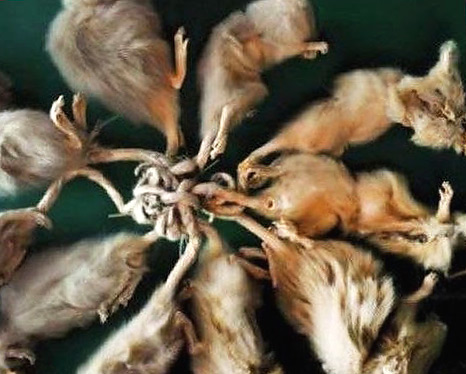
And his x-ray:
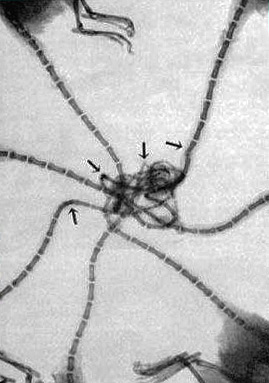
Most scientists interpret this data as follows: for rare reasons, the tails of rats stick together and get mixed up, after which the animals die relatively quickly either from starvation or from the same reasons that caused the tails to be mixed up. And these reasons can be quite banal, despite the uniqueness of their consequences.
Reasons why rats could grow together
There are several hypotheses about the causes of the appearance of rat kings. Considering them, you need to consider the actual data:
- All rat kings were found only in areas with a temperate and cold climate;
- This phenomenon is known only to black and rice rats, as well as mice. In Pasyuk rat kings are not known and have never been discovered.
Some researchers believe that rats “grow together” with their tails due to life in very tight spaces, where the tails themselves are constantly intertwined and sooner or later can be tied into a knot.
Other experts believe that the causes of interweaving are unsanitary conditions, in which the tails of animals stick together due to food debris on them, blood, dirt and earth.
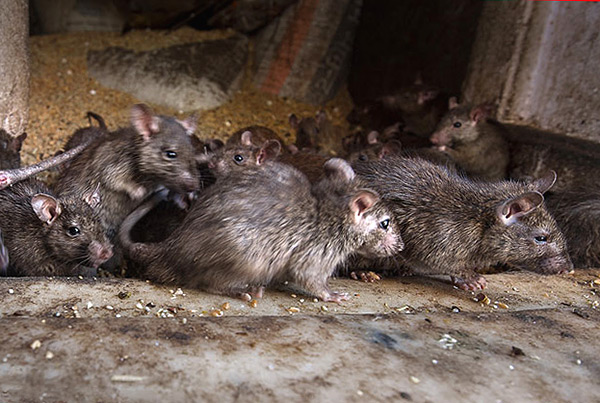
The photo below shows what a very large rat king of several dozen rats looks like:
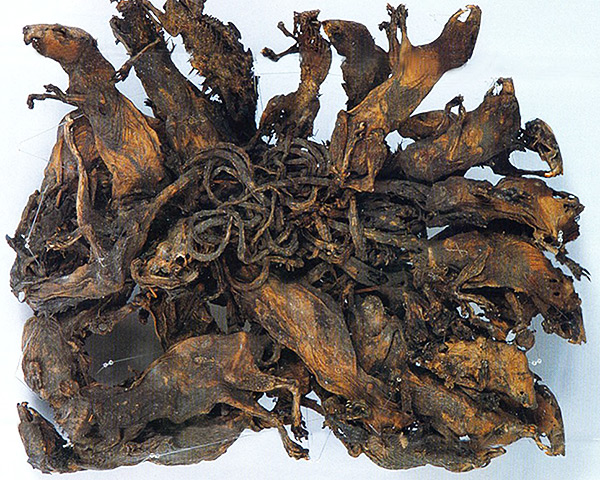
But these hypotheses do not explain all the facts. It is not clear, for example, why kings are not found in the tropics, where rats are more numerous, live in very dense colonies and often make nests in the litter of gardens and plantations, among rotting foliage and fruits? After all, the probability of sticking tails here is higher ...
A more likely theory is that rat tails freeze when sleeping in cold burrows. In such shelters, animals are taken in large quantities to warm themselves, but on especially cold nights even their accumulation does not provide sufficient temperature - as a result, moisture on the hairs freezes, tails stick together. Unhygienic conditions here also contribute to the coalescence of tails (they often turn out to be smeared with excrement), but this is not the main reason. After awakening, the animals try to scatter, rush about in different directions and get entangled even more.
It is interesting
This hypothesis also has experimental evidence. In the laboratory, rats were tied together with glue, and then, literally for several hours, they were intertwined exactly like the knots of real rat kings. Even after washing off the glue, the animals could not untangle.
The photo shows what the rat tail looks like at a strong zoom:
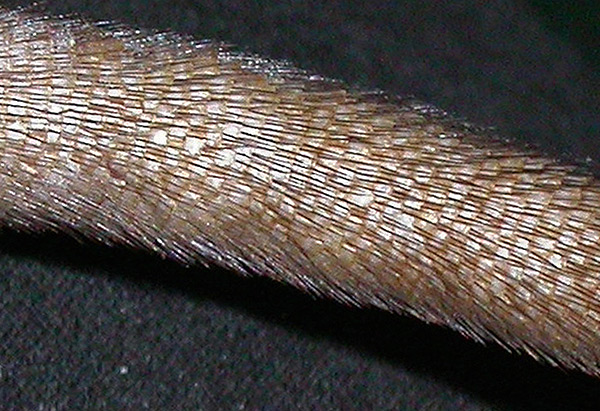
It is enough for several tens of hairs on two (or more) tails to stick together so that the animals could not disconnect them without injuries. To a person who has ever stuck his tongue to frozen metal, this phenomenon is completely understandable.
In addition, the tail freezing hypothesis explains some facts. Gray rats do not have “kings" because their tails are short and less mobile than black ones, it is more difficult to confuse them. In a warm climate, no rats fall into conditions under which the tails can freeze to each other.
Therefore, it is freezing during collective nights that is considered the most reliable reason for the appearance of rat kings. It means, by the way, that such an event is only a tragedy for animals. They are definitely not fed by relatives, they certainly do not have any “power” and are doomed to painful death from hunger, cold and stress.
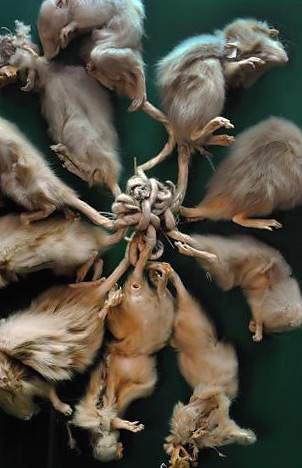
The same theory explains why no living rat kings were discovered. Not only is this phenomenon very rare, but also animals with tangled tails cannot get out of their shelters and catch the eye of a person. After the animals were trapped, they die of starvation on the fifth or seventh day.
The probability that during these days a person will find and open a shelter is negligible. And even if the case from Estonia is true, it is the exception that confirms the rule.
The hierarchy of the rat flock and the possibility of the existence of "main rats"
In rat flocks there is no pronounced subordination of individuals. There are leaders, both males and females, but the dominant position allows them only to occupy the best shelters. Also, in conditions of high population density, when too many rats live on a unit of space, it is the individual leaders who primarily participate in breeding. Animals on the lower levels of the hierarchy often do not participate in this celebration of life.

Thus, even in a very large and dense rat flock the “rat king” cannot live, who would give some orders and who would be fed by other individuals. Even animal leaders, along with the rest, participate in obtaining food and raising offspring, equally at risk of being caught and poisoned.
And one more thing: small local rat populations can represent a large family, a group of descendants of one single female. Considering that the rat itself lives and breeds up to 3-4 years, and each new brood of 8-15 rat pups appears every month and a half, and its own descendants begin to breed 7-8 months after birth, by the end of life such a mother - the heroine can be surrounded by hundreds of descendants of different generations.
This female does not have special privileges, but is usually one of the leaders in the population. If you wish the reader, she is the queen of rats.
Can people command rats and be rat kings
Also in mythology and in various folk tales there are references to people who in one way or another controlled rats. The most famous of these legends tells of a Hameln Pied Piper, who, by order of the German city authorities, flirted all the rats in the pond by playing the flute and drowned there, and when the authorities refused to pay the fee, he did the same with a group of children.
It is noteworthy that this story is very widespread and seems to be based on some real historical events, since many of its formulations in the literature indicate specific dates.Most interpretations indicate that the Pied Piper introduced rats into hypnosis with his music, and children with unusual manners and colorful clothes.
Below is a picture of a Hameln Pied Piper:
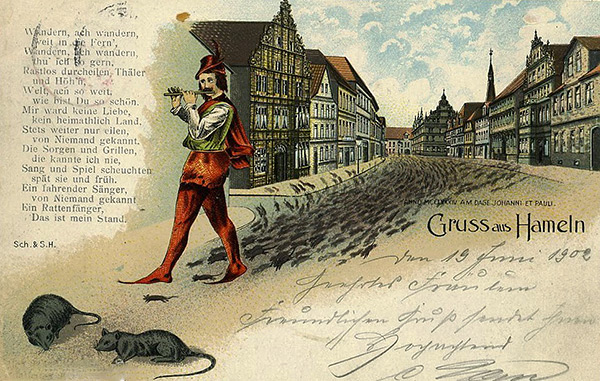
Such pictures, generally speaking, are quite numerous, although the images of the Pied Piper on them can vary significantly.
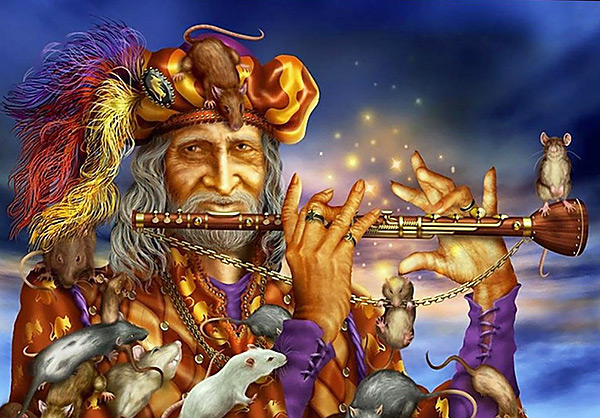
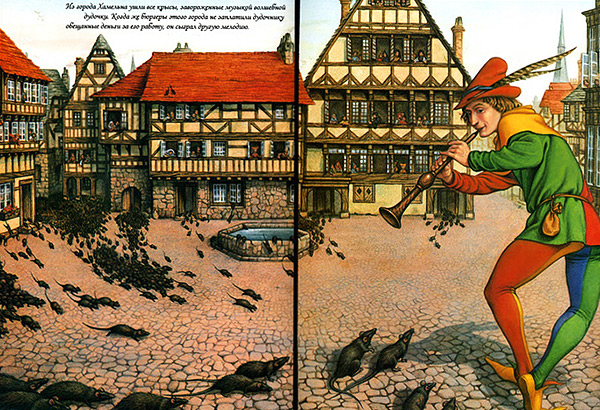
There are historical reports of people who in one way or another controlled the rats, or inexplicably drove them out of the cities. Many of these messages are typical legends or metaphors, but among them are those that look more or less reliable.
Today, however, such abilities of a person that would allow him to control the behavior of rats have not been discovered and confirmed. Yes, animals can be frightened by sounds or smells, tame individuals can be trained, but a person is not capable of forcing wild rats to perform certain actions anywhere. So, reports of such people can be safely considered fairy tales or metaphors.
Signs and myths associated with rat kings
Among the people, the discovery of the rat king has always been considered a bad omen. From the Middle Ages, it has come to be believed that the rat king brings illness and death to the house of the person who discovered him.
In principle, such an omen has a rational grain: rats are satellites of unsanitary conditions, carriers of many diseases. It was they in the Middle Ages that caused the pandemic of the plague, which literally devastated some European countries and led to the deaths of millions of people. The fact of finding a rat king means that there are too many rats in a particular place, and that they live in very difficult conditions.

Similarly, ancient dream books consider dreaming rats, woven with tails, as an omen of a serious illness.
In ancient mythology, it was also believed that the rat king found on the ship portends the flooding of the ship itself. It is noteworthy that there are no reports (even unconfirmed) of the findings of the “kings" on the ships.
So we make the final conclusion: the rat king is most likely an accident during which the animals freeze and get tangled up, cannot move and get food, and as a result die of starvation. Because of the rarity of such a phenomenon, it seems to man something supernatural, and because of the disgust that many people have for rats, bad signs and beliefs are associated with it.
Interesting video: facts about the rat king
Huge Rat Cat Fight



